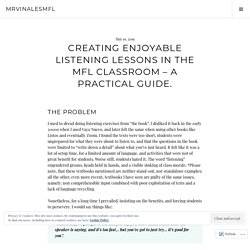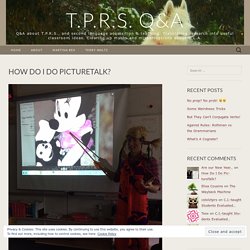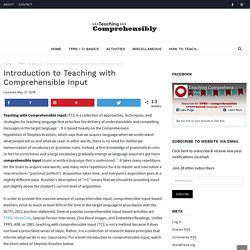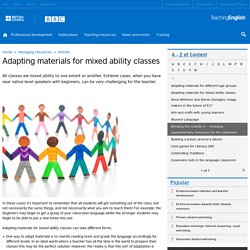

Profe Peplinski - Profe's Blog. Anyone who has children (or who has worked with them closely) knows that when a kid finds a favorite book, they like to hear the same story approximately 1,356 times.

There is some research that shows that hearing repeat stories is comforting and helps children learn new words. Middle School Mob. #FinishStrong - Mrs. Spangler in the Middle. I'm so glad to join Forever in 5th Grade for Show and Tell!

My show and tell is focused on my end of the year motto: Finish Strong! First up, I found this neat inspirational video (among a host of other great ones from Simple Truths) 'Here is a story! Story it is': how fairytales are told in other tongues. In Tamil, folk stories and fairytales, the sort that grandparents tell grandchildren before bed, often begin, “In that only place…”.

In another Indian language, Telugu, stories start “Having been said and said and said…”. In English, of course, it is “Once upon a time…”. Chitra Soundar, an Indian-British author and storyteller, was thinking about her grandmother’s stories, which always began with the classic Tamil opener, when she asked people on Twitter to share how stories began in their languages. Grades and Performance Assessments. Editing Children's Books Project + Input = Happy Class. Lesson Planning Templates - secondary - Google Drive editable.
Creating enjoyable listening lessons in the MFL classroom – a practical guide. – mrvinalesmfl. The problem I used to dread doing listening exercises from “the book”.

I disliked it back in the early 2000s when I used Vaya Nuevo, and later felt the same when using other books like Listos and eventually Zoom. I found the texts were too short, students were unprepared for what they were about to listen to, and that the questions in the book were limited to “write down a detail” about what you’ve just heard. It felt like it was a lot of setup time, for a limited amount of language, and activities that were not of great benefit for students.
Worse still, students hated it. Pursuing Proficiency – World Language Laboratory: Pursuing Proficiency. Creating a language educator identity: What does French look like chez nous?

Who am I as a World Language teacher? I am engaged participant in the ever-evolving sphere of proficiency and thematic-based educators who constantly discuss, describe, and reconsider their practices. My scope and sequence – Kristy Placido. Carrie Toth recently published a great set of documents of her scope and sequence of units and activities for each of her classes, and it made me realize that I have not updated my own “What I teach” posts in a really long time, and things tend to change for me at least a little each year as new readers are published, new songs and movies come out, and the world keeps spinning!

So, thank you Carrie, for reminding me to get up to date! Spanish 2 Semester 1: We watch Mi vida loca on Fridays during the 1st semester (we spend about 15 minutes on each episode including a bit of discussion or a short activity). Kicking off Free Reading in Level 1. Tomorrow my little darlings start 2nd semester and I can’t wait to get my Spanish 1s reading independently.

I can’t wait to get started because: Free Reading is good for them.Free Reading is good for me. Because they’re getting input that’s not coming out of my mouth. Resources- All the Pages - Profe Peplinski. Participation-Self-Assessment. Classroom Management Worksheet for Spanish. Why You Should Never Use Reflection Forms. How to Learn a Language: INPUT (Why most methods don't work) Ben Slavic. Rigor-poster-spanish. Language Learning. Adrianaramirez.ca. How to measure 'success' in the classroom? Stop laminating and start motivati...
Write & Discuss example – My generation of polyglots. How Do I Do PictureTalk? Profe, working diligently to maintain student interest.

Other than MovieTalk, PictureTalk is the single-best “add-on” to any C.I. program, and an amazing strategy for non-c.i. teachers. It reinforces already-taught vocabulary and grammar, and is also a superb way to introduce new vocab pre-story. Picturetalk– what Ben Slavic calls “Look and Discuss”– is simple, easy, low-prep and effective. Introduction to Teaching with Comprehensible Input (TCI) Teaching with Comprehensible Input (TCI) is a collection of approaches, techniques, and strategies for teaching language that prioritize the delivery of understandable and compelling messages in the target language .

It is based heavily on the Comprehension Hypothesis of Stephen Krashen, which says that we acquire language when we understand what people tell us and what we read. In other words, there is no need for deliberate memorization of vocabulary or grammar rules. Adapting materials for mixed ability classes. In these cases it’s important to remember that all students will get something out of the class, but not necessarily the same things, and not necessarily what you aim to teach them!

For example, the beginners may begin to get a grasp of your classroom language whilst the stronger students may begin to be able to put a new tense into use. Adapting materials for mixed ability classes can take different forms. One way to adapt materials is to rewrite reading texts and grade the language accordingly for different levels. In an ideal world where a teacher has all the time in the world to prepare their classes this may be the perfect solution. However, the reality is that this sort of adaptation is extremely time consuming and not many teachers can actually go to this length to adapt materials for mixed level groups. Motivating speaking activities for lower levels. Planning time has been shown to increase production in speaking tasks. Lower level learners often find it especially difficult to speak spontaneously, so these activities incorporate 'thinking time' during which learners can prepare for speaking by planning what they are going to say, and asking the teacher or using a dictionary to look up missing vocabulary.
The following activities are relatively short, with minimal materials preparation time for the teacher. COLLABORATIVE STORYTELLING. John McWhorter: 4 reasons to learn a new language. We had an AWESOME training with Jodi... - Tech for World Language Teachers. Why I Got Rid of Homework in Spanish Class - Mis Clases Locas. Inside: Why I ditched homework in Spanish class. Disclaimer: I am a #deptof1 at a tiny school and have pretty much 100% control of what happens in my classroom.
Kagan Publishing & Professional Development - KaganOnline.com. Le support visuel dans l’apprentissage d’une langue étrangère - Le français i... Bienvenue sur Le Français illustré, the blog that offers you painless, useful and comprehensible input ! If you are new here, you will probably want to know more about the power of illustrations to learn French. How I teach lexicogrammar (PART 2) – The 8 tenets of Extensive Processing In...
Les cartes mentales illustrées pour apprendre le français, façon “Le français... Fluency Matters Training – Lifetime learning, 20 minutes at a time. TPRS® 101, Step Four: Debrief. This is the fourth post in the series “TPRS® 101: Teaching Proficiency is Really Simple“. By now, the acronyms TPRS®, CI, and TCI are rolling off your lips without a second thought. You understand the goal of a TPRS® lesson, and you’ve seen one in action. Maybe you used this list to find a teacher near you to observe, or perhaps you were lucky enough to attend iFLT or NTPRS. Or maybe you had to settle for watching videos of TPRS® lessons until school starts up again and you can get into an actual classroom to observe. Regardless of how it happened, you’ve seen a TPRS® lesson.
For Teachers New to CI Methods. Get ’em moving! – Loading up my little darlings with Comprehensible Input. I heard once, “if their bum is numb, so is their brain”. I don’t know who said it or when (it was a loooooong time ago) but it stuck with me. (My husband just suggested a new saying “if their bum is numb, their brain is dumb” Same idea, anyway.) Here are some of my favorite ways to move them around and wake them up! Muévete si…. Move if… It’s easy and requires no prep at all. Animal Partners. Brain Breaks- ACTFL 2018.pdf.
Brain Breaks- ACTFL 2018.pdf. The Deskless Classroom: The Highly Structured Class pays off! (Procedures and... Last year, I had a couple of tough classes. Really, really tough classes. They had great attitudes and were excited about learning, but never, ever stopped talking. ABCs of Spanish 17-18.docx. HUTIN - Youtube à l'école. In Language Classrooms, Students Should Be Talking. We have gotten it wrong, really wrong, in the language classroom. Historically, the teacher stood at the front of the classroom spouting details of grammar. Students sat at desks placed in straight rows directed toward the teacher and madly took notes. A thoughtful and engaging post by... - American Association of Teachers of F... La pub dans la classe de FLE. The Proficiency Path: Step 1. Thanks to everyone who answered the poll questions!
Based on the results, we will take a walk on the proficiency path and stop along the way to smell all the flowers. I hope we visit ones that are useful for you. The Proficiency Path: Step 2. Now that you are familiar with the proficiency levels, it is time to set realistic expectations for your students. The last thing you want is for them, and you, to be frustrated. The Proficiency Path: Step 5. We have the proficiency target and the “I can” goals.
Now we will skip to the end of the unit and create the assessment, aka Backward design. The Proficiency Path: Step 4. The Proficiency Path: Step 3. Now the fun begins! Language advocacy starts with you. Grading: it’s only a matter of time! Tsdwlstandards - TSD new district rubrics. Creativelanguageclass - Rubrics. Integrated Performance Assessments. Published November 2013 In the beginning, I gave very grammar-focused tests. As my teaching style changed, I found that my tests didn’t match what we were doing in class. 3 Steps for Creating an Engaging Presentational Assessment. Pecha Kucha about 17 Listening Activities. 4 Steps for Smooth Interpersonal Assessments. French. TELL SelfAssessment PF. Progress toward Proficiency: Supporting Student Learning. – Lynn Johnston. The Path to Proficiency. Strategies to Guide Learners to Their Next Proficiency Level: Series Overview.
World Readiness Standards Overview. Exit Slip Posters. Let AuthRes Take the Lead ~ Step 2. Track Goals with Stamp Sheets.